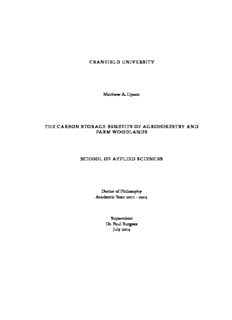
The carbon storage benefits of agroforestry and farm woodlands PDF
Preview The carbon storage benefits of agroforestry and farm woodlands
CRANFIELD UNIVERSITY Matthew A. Upson THE CARBON STORAGE BENEFITS OF AGROFORESTRY AND FARM WOODLANDS SCHOOL OF APPLIED SCIENCES Doctor of Philosophy 2011 2014 Academic Year: - Supervisor: Dr. Paul Burgess 2014 July CRANFIELD UNIVERSITY Matthew A. Upson THE CARBON STORAGE BENEFITS OF AGROFORESTRY AND FARM WOODLANDS School of Applied Sciences This thesis is submitted in partial fulfilment of the requirements for the degree of Doctor of philosophy. Doctor of Philosophy 2011 2014 Academic Year - Supervisor: Dr. Paul Burgess 2014 July ©CranfieldUniversity,July2014.Allrightsreserved.Nopartofthispublicationmaybe reproducedwithoutthewrittenpermissionofthecopyrightholder. Matthew A. Upson: The carbon storage benefits of agroforestry and farm woodlands, © 2014 Cranfield University, July . All rights reserved. No part of this publication may be reproduced without the written permission of the copyright holder. v ABSTRACT Plantingtreesonagriculturallandeitherasfarmwoodlandsoragroforestry(trees integratedwithfarming)isoneoptionforreducingthelevelofatmosphericcarbon dioxide. Trees store carbon as biomass, and may increase carbon storage in the ground. A review of the literature outlined uncertainty relating to changes in carbon storage after planting trees on agricultural land. The aim of this thesis is to deter- minetheimpactoftreeplantingonarableandpasturelandintermsofaboveand belowground carbon storage and thereby address these uncertainties, and assess the implications for the Woodland Carbon Code: a voluntary standard for carbon storage in UK woodlands. Measurementsofsoilorganiccarbontoadepthof1.5mweretakenattwofield sites in Bedfordshire in the UK: a 19 year old silvoarable trial, and a 14 year old silvopasture and farm woodland. On average 60% and 40% of the soil carbon (rel- ative to 1.5 m) was found beneath 0.2 and 0.4 m in depth respectively. Whilst tree planting in the arable system showed gains in soil organic carbon (12.4 t C ha−1 at 0–40 cm), tree planting in the pasture was associated with losses of soil organic carbon (6.1–13.4 t C ha−1 at 0–10 cm). Evidence from a nearby mature grazed woodland indicate that these losses may be recovered. No differences associated with tree planting were found to the full 1.5 m, though this may be due to a lack of statistical power. Measurements of above and belowground biomass, and the root distribution of 19 year old poplar (Populus spp.) trees (at the silvoarable trial) and ash (Fraxinus excelsior)treesrangingfrom7to21years(atseveralfieldsitesacrossBedfordshire) were made, involving the destructive harvest of 48 trees. These measurements suggest that Forestry Commission yield tables overestimate yield for poplar trees growninasilvoarablesystem.Anallometricrelationshipfordeterminingashtree biomass from diameter measurements was established. ThebiophysicalmodelYield-SAFEwasupdatedtotakeintoaccountrootgrowth, and was parameterised using field measurements. It was successfully used to describe existing tree growth at two sites, and was then used to predict future biomass carbon storage at the silvoarable trial. Measurements indicate that losses in soil carbon at relatively shallow depths can offset a large proportion of the carbon stored in tree biomass, but assessing changes on a site by site basis may be prohibitively expensive for schemes such as the Woodland Carbon Code. keywords : Agroforestry, Soil organic carbon, Woodland Carbon Code, Soil carbon fractiona- tion, Yield tables, Modelling, Carbon storage vii A philosopher, which is what I am supposed to be, is a sort of intellectual yokel who gapes and stares at what sensible people take for granted, a person who cannot get rid of the feeling that the barest facts of everyday life are unbelievably odd. As Aristotle put it: the beginning of philosophy is wonder. 1915 1973 — Alan Wilson Watts ( - )
Description: